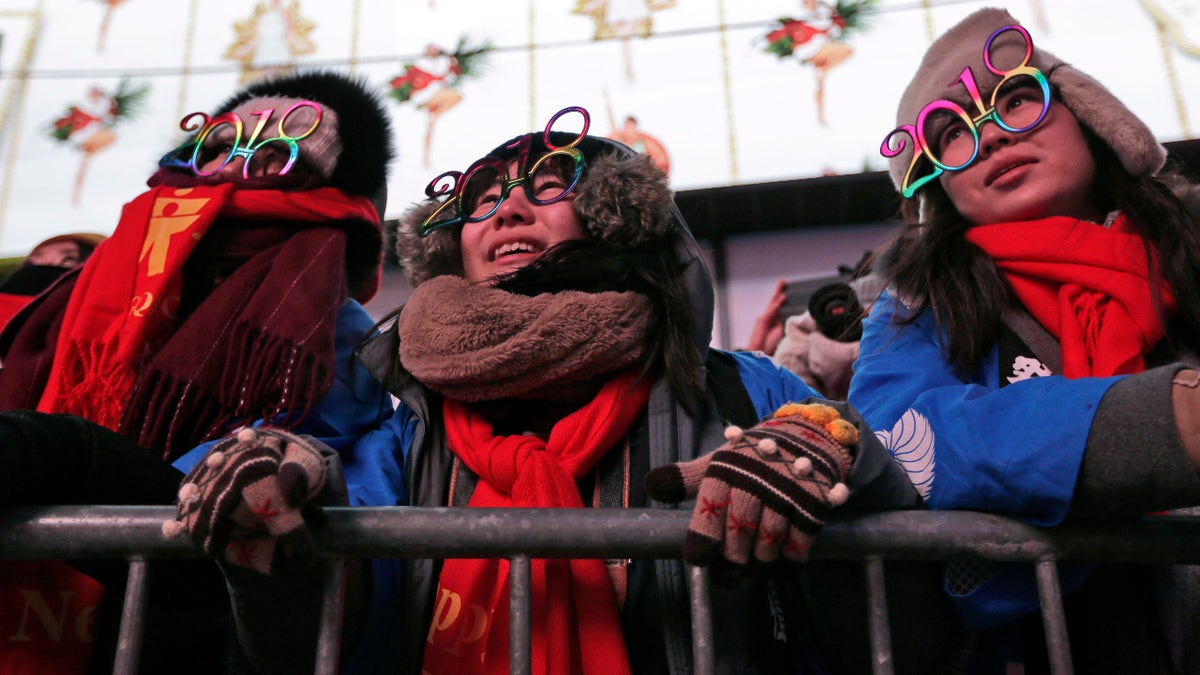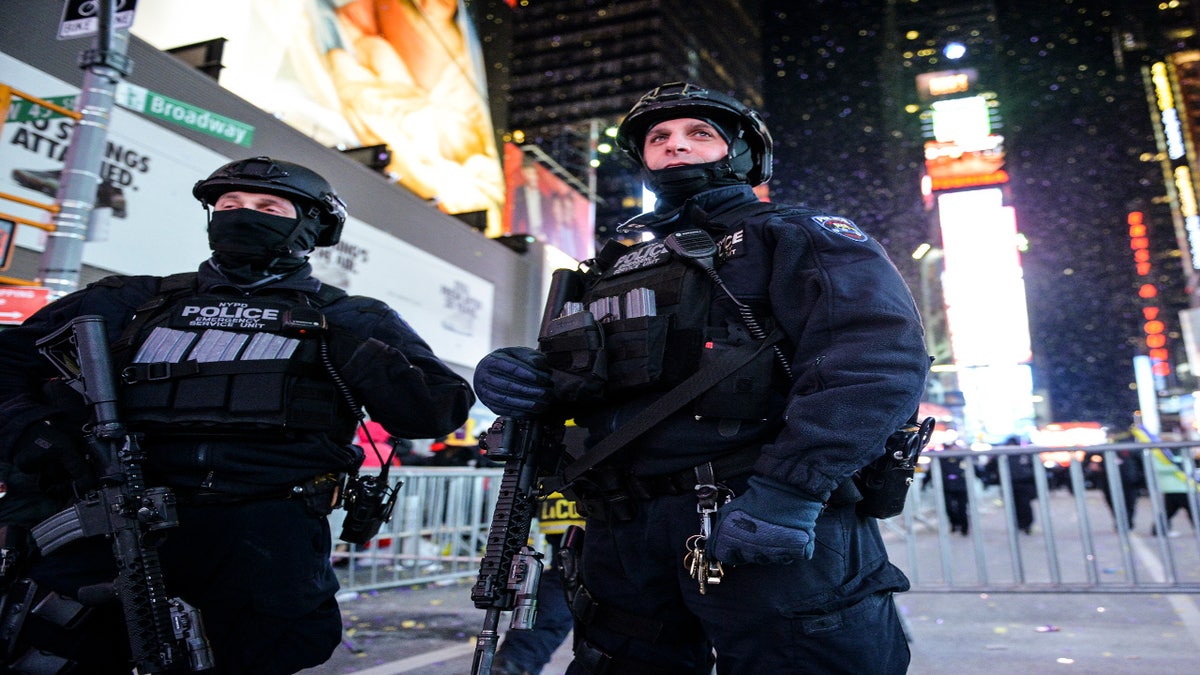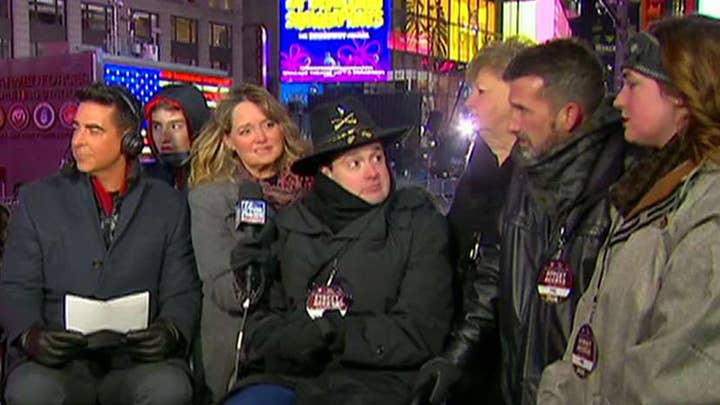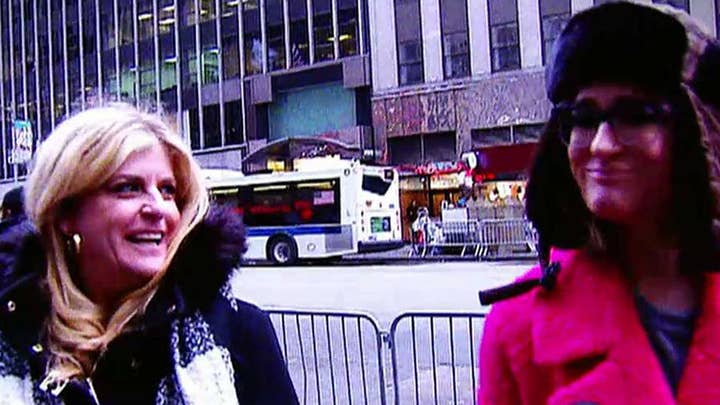
New Year's Eve revelers at Times Square in New York City dressed appropriately. From left are Elena Bardunniotis, Dominic Manshadi and Sarah Thompson, of Long Beach, Calif. (Associated Press)
A temperature of 10 degrees Fahrenheit as the ball dropped made the welcoming of 2018 the second-coldest New Year’s Eve on record in the Big Apple.
The glittering crystal ball dropped with a burst of confetti and dazzling fireworks as revelers said goodbye to 2017.
With much of the East Coast experiencing a recent snap of frigid, Arctic weather, the traditional celebration was less crowded than in past years. Some of the metal pens, usually packed with people, were only half-full.
Some revelers, bundled up in hats, gloves, face masks and numerous layers of clothing, jogged to keep warm, others bounced and danced. Some stood and shivered.

Revelers watch rehearsals of New Year's celebrations in Times Square, New York City, Dec. 31, 2017. (Associated Press)
But those who showed up were there to watch the traditional drop of a Waterford Crystal ball down a pole atop 1 Times Square.
This year, the ball was 12 feet in diameter, weighed 11,875 pounds and was covered with 2,688 triangles that changed colors like a kaleidoscope, illuminated by 32,256 LED lights. When the first ball drop happened in 1907, it was made of iron and wood and adorned with 100 25-watt light bulbs.
The first celebration in the area was in 1904, the year the city's first subway line started running.
Taking no chances
After two terrorist attacks and a rampaging SUV driver who plowed into a crowd on the very spot where the party takes place, police were taking no chances.
Security was tighter than ever before. Garages in the area were sealed off. Detectives were stationed at area hotels working with security officials to prevent sniper attacks.

New York City Police Emergency Service Unit officers stand on guard in Times Square during New Year's Eve celebrations, Dec. 31, 2017. (Associated Press)
Thousands of uniformed officers lined the streets. Concrete blocks and sanitation trucks blocked vehicles from entering the secure area where spectators gathered. Partygoers passed through one of a dozen checkpoints where they were screened and then screened again as they made their way to the main event.
At 48th Street and Seventh Avenue, Chris Garcia, his girlfriend, Zayra Velazquez, and her brother Edgar Valdez stood rigidly, having waited in the cold for almost six hours. Valdez said he felt "pretty safe" at the event.
"They checked us pretty good," he said. "Police checked what we had, and another scanned us with metal detectors."
The police department estimates that it costs $7.5 million to protect the event.
Chilly past
The frostiest ball drop on record was 1 degree Fahrenheit, in 1907. In 1962 it was just 11 degrees Fahrenheit outside, and in 1939 and 2008 it was 18 degrees Fahrenheit.
Remle Scott and her boyfriend, Brad Whittaker, of San Diego, arrived shortly after 9 a.m., saying they were trying to keep a positive attitude as temperatures hovered in the teens. Each was wearing several layers of clothing.
"Our toes are frozen, so we're just dealing with it by dancing," Scott said.
"Our toes are frozen, so we're just dealing with it by dancing."
Some wore red scarfs that read "Happy New Year" and others donned yellow and purple hats as a pizza deliveryman sold pies to the hungry crowd.
In a prime viewing spot near 42nd Street, Alexander Ebrahim grinned as he looked around at the flashing lights of Times Square.
"I always saw it on TV, so I thought why not come out and see it in person," the Orange County, California, resident said. "It's an experience you can never forget."
Michael Waller made a snap decision on Saturday evening to drive straight from Columbus, Ohio. He made it to Times Square at 8 a.m. and waited all day in front of the ball.
"I didn't want to stay home for this, by myself," he said.
Just minutes after midnight, partygoers started to drain from the area as if a giant tub stopper has been pulled up.
And immediately the cleanup began, led by a small army of city employees -- including more than 200 sanitation workers.
Crews removed more than 44 tons of debris last year.
The Associated Press contributed to this story.



